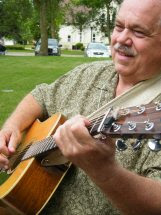I've been revisiting a couple of songs I've done for a long time and trying them out as 'bob-i-lynn' possiblities. One is a 60's folk song, the other is a jamming song usually done by a bunch-of-guys.
I first learned I Can't Help Wonder Where I'm Bound in college. This is 60's 'folk standard' by Tom Paxton - when I first did it, I finger-picked it - I switched it to a more flat-picky version after hearing Bill Cagley and others perform it in a 'bluegrassy' way. I did in D (using C position with Capo on 2nd fret). I recently heard it done by the Country Gentlemen or some such group (late 60s or 70s) - they had changed the melody etc, not the way I did it at jams etc.. In any event I hadn't played it much at all for the last few years, until a month or two ago I tried in on the [insert drum roll here!] ... the 12 String. Of course, it's now in the key of F. Lynn and I tried it at a recent rehearsal and we'll probably perform it at some point when we do multiple sets at a coffee shop (when its worth it to bring the 12-string and the old-time purists are not around).
More Pretty Girls Than One is an old time song that I learned a long time ago, probably from a Doc Watson recording. This is standard jam fare and I used to do it at Noel Johnson's Ground Hog Day Jams among others. I recently picked up a version (in mp3 format) done by the Prarie Ramblers (originally on a 78). Their version added the following verse:
Little girl, you turned me down,
You left me all alone
So I'm leaving you this lonseome song
To sing when I am gone.
This verse made me consider it for bob-i-lynn purposes since it takes the song in a different direction from the swaggering way I had always interpreted it (based on the following):
Look down that lonesome road,
Hang down your head and cry,
'Cause I'm thinking about all the pretty girls
and hoping that I never die.
We're played it a couple times in D (I have capo on 2nd fret using C position) with Lynn on fiddle. I had usually done it in C, but for preforming a little higher should work - there is an A minor chord that I will probably leave as C (makes it a little more old-timey without the minor). Since this in 3/4 time it looks to be a good addition to our mostly 4/4 repertoire.
Thursday, June 7, 2007
Subscribe to:
Post Comments (Atom)

No comments:
Post a Comment